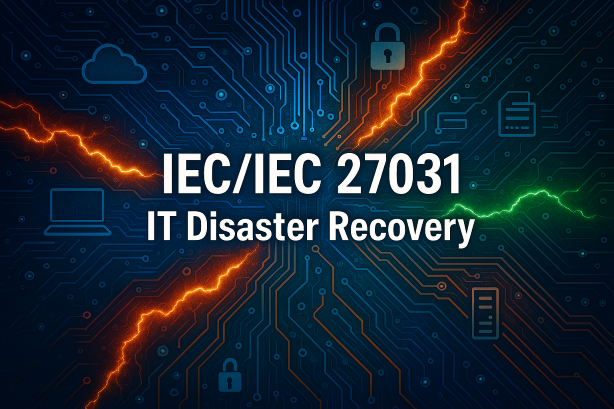
Status: Final Blueprint (Summary)
Author: Shahab Al Yamin Chawdhury
Organization: Principal Architect & Consultant Group
Research Date: July 28, 2025
Version: 1.0
1. Executive Summary
This document provides a condensed, strategic roadmap for implementing ISO/IEC 27031 to establish a robust ICT Readiness for Business Continuity (IRBC) program. It follows the Plan-Do-Check-Act (PDCA) cycle to build a resilient framework that integrates with ISO 22301 (Business Continuity) and ISO 27001 (Information Security). The core objective is to move beyond reactive disaster recovery to a proactive state of digital resilience, driven by data from a Business Impact Analysis (BIA) and Risk Assessment (RA). The outputs are designed for visualization in a dynamic executive dashboard.
2. The PDCA Implementation Cycle
Phase 1: Plan – Governance, Policy, and Scoping
This phase establishes the program’s authority and strategic direction.
- Governance: Secure executive sponsorship via a Steering Committee (chaired by CIO/CRO) and appoint an IRBC Program Manager. Define clear roles using a RACI matrix.
- Policy: Create a formal, high-level IRBC Policy that defines the program’s scope, objectives, and commitment to continual improvement.
- Integration: Align the IRBC program with the enterprise BCMS (ISO 22301) and ISMS (ISO 27001), using the BIA from the BCMS as a primary input and fulfilling the ISMS control A.5.30.
- The Six Pillars: Base all strategic planning on the six core components mandated by ISO 27031:
- Skills: Ensuring competent personnel are available for recovery.
- Facilities: Providing a secure physical environment and recovery sites.
- Technology: Implementing resilient hardware, software, and networks.
- Data: Protecting data integrity and availability via backups and replication.
- Processes: Defining operational procedures for incident management and recovery.
- Suppliers: Managing risks associated with third-party vendors and cloud providers.
Phase 2: Plan – BIA, Risk Assessment, and Strategy
This phase is the analytical core, providing the data to make informed decisions.
- Business Impact Analysis (BIA): Identify critical business processes and their ICT dependencies to define two key metrics:
- Recovery Time Objective (RTO): Maximum acceptable downtime.
- Recovery Point Objective (RPO): Maximum acceptable data loss.
| Business Process | Criticality (1-5) | RTO (Hrs) | RPO (Mins) | Supporting ICT Services |
| Online Transaction Processing | 5 | 1 | 0 | Web Servers, Oracle DB |
| Manufacturing Execution System | 5 | 4 | 15 | MES App, SCADA, SQL Server |
| Financial Reporting | 4 | 24 | 240 | SAP ERP, Data Warehouse |
| Human Resources Payroll | 3 | 48 | 1440 | HRIS System |
- Risk Assessment (RA): Identify threats and vulnerabilities that could impact the availability of critical ICT services. Prioritize risks based on likelihood and impact.
| Risk ID | Threat | Likelihood (1-5) | Impact (1-5) | Risk Score | Recommended Treatment |
| RA-001 | Ransomware Attack | 4 | 5 | 20 | Immutable backups, network segmentation. |
| RA-002 | Data Center Power Outage | 3 | 5 | 15 | Install backup generator. |
| RA-003 | Fiber Cut (ISP Outage) | 4 | 4 | 16 | Contract secondary ISP with diverse path. |
- Tiered Strategy Development: Group services into tiers based on their RTO/RPO to balance cost and resilience.
| Tier | RTO/RPO Requirement | Selected Strategy | Est. Cost |
| 1 | RTO: < 1 hr; RPO: 0 min | Active-Active Multi-AZ Cloud | High |
| 2 | RTO: < 4 hrs; RPO: < 15 min | Hot Site Failover (Replication) | Medium |
| 3 | RTO: < 24 hrs; RPO: < 4 hrs | Cloud DRaaS (Backups) | Low |
| 4 | RTO: > 72 hrs; RPO: < 24 hrs | Restore from Backups | Very Low |
Phase 3: Do – Implementation and Training
This phase translates strategy into tangible capabilities.
- Develop Recovery Plans: Create clear, concise, and actionable recovery plans for each critical ICT service. Plans must be version-controlled and stored in an accessible off-site location.
- Implement Controls: Deploy the technical solutions defined in the tiered strategy (e.g., high-availability clusters, data replication, immutable backups).
- Training & Awareness: Conduct role-specific training for all recovery team members and general awareness training for all staff. A plan is useless if people are not trained to execute it.
Phase 4: Check – Testing and Measurement
This phase validates that the plans and technologies work as intended.
- Testing Program: Implement a progressive testing schedule:
- Tabletop Exercises: Discussion-based plan walkthroughs.
- Component Tests: Hands-on tests of individual systems.
- Integrated Tests: End-to-end recovery of a full application stack.
- Full Failover: Live failover of production to the recovery site.
- Performance Management (KPIs): Track key metrics to measure program health and report to management via a dashboard. Key KPIs include RTO/RPO Adherence, % Uptime of Critical Services, and Test Pass Rate.
| Test ID | Test Type | Systems in Scope | Date | Result | Key Finding |
| TEST-2025-03 | Integrated | E-Commerce Platform | Q3 2025 | Fail | Firewall rule at DR site blocked DB connection. |
| TEST-2025-04 | Full Failover | MES System | Q4 2025 | Planned | N/A |
Phase 5: Act – Continual Improvement
This phase ensures the IRBC program evolves and matures over time.
- Management Review: The Steering Committee must formally review the program’s performance, test results, and risk posture at least annually to provide oversight and allocate resources.
- Corrective Action (CAPA): All gaps and issues identified during tests or audits must be logged in a Corrective Action Plan. Each issue requires a root cause analysis, a remediation plan with an owner and due date, and verification upon completion.
- Lifecycle Maintenance: Continuously update plans, BIA/RA data, and technical documentation to reflect changes in the business and technology environment.
By following this lifecycle, an organization transforms ICT continuity from a static project into a dynamic, sustainable capability for digital resilience.